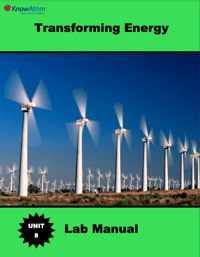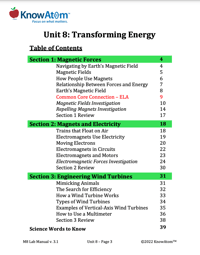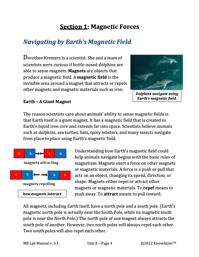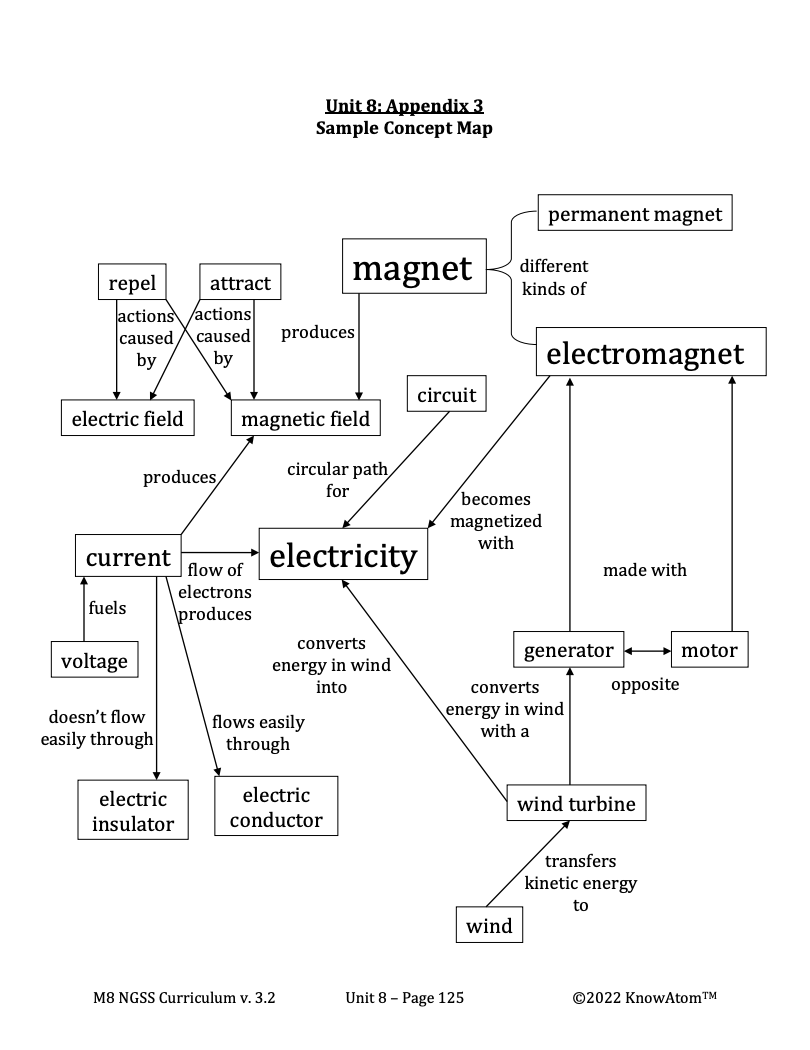In this lesson, students use what they know about magnets, forces, energy transfer, and generators to engineer a vertical-axis wind turbine that generates a specific amount of electrical energy in both low and high wind speeds.
In this unit, students investigate the phenomena of magnetic and electric fields as they explore how objects can interact with other objects without coming into contact with them. For this lesson, students use their understanding of the phenomena to engineer wind turbines that use a generator to produce electricity. This page provides an overview of this lesson.
The science background section gives teachers more in-depth information on the phenomena students explore. Here is an excerpt from this lesson on engineering wind turbines.
Generators are also machines that use permanent magnets and electromagnets. A generator is a machine that converts an input of kinetic energy into an output of electrical energy. The generator uses the same principles of electromagnetic force as an electric motor, but it works in reverse. A generator uses kinetic energy to move a magnet near a wire conductor, which creates a flow of electrons, generating electricity.
Engineers can use generators in various technologies that generate energy, including wind turbines, which are devices that convert the wind’s kinetic energy into electrical energy. The wind has kinetic energy because it is moving air. Wind turbines can be as tall as a 20-story building and have blades that are 60 meters (200 feet) long. Basic wind turbines have three parts: blades, a drive shaft, and a generator.
The generator is able to move because the blades of a wind turbine capture the wind’s kinetic energy. The wind pushes on the blades, transferring some of its own kinetic energy of motion to the blades. The blades are connected to a drive shaft, which is a long bar of steel that can rotate. As the wind moves the blades, the blades rotate the drive shaft. That rotating motion moves the electromagnet in the generator, which produces electricity.
Engineers experiment with different blade shape and size depending on the specific environmental conditions. There are two basic designs: vertical-axis wind turbines and horizontal-axis wind turbines.
Horizontal-axis turbines are much more common because they are generally more efficient at converting the wind’s kinetic energy into electricity. They look like massive airplane propellers on a pole.
However, horizontal-axis wind turbines work most efficiently when the wind flows at a right angle to the blades. This means that the main rotating shaft and electrical generator must be pointed into the wind. They are also very tall, with long, heavy blades. The more mass the blades have, the more force is needed to turn them. This makes them best suited for open spaces, such as fields, that have a lot of wind.
The other kind of turbine is called a vertical-axis wind turbine, and it often looks like a massive egg beater. In the vertical-axis wind turbine, the main drive shaft is perpendicular to the ground. The main components are located at the base, making any service and repair much easier. One advantage of the vertical- axis wind turbine is that it does not need to be pointed into the wind. It will function similarly regardless of wind direction. This makes it a better option for many urban areas where tall buildings make wind flow more unpredictable. However, this design is less efficient than horizontal-axis turbines because the blades rotate more slowly.
In this lesson, students use what they know about magnets, forces, energy transfer, and generators to engineer a vertical-axis wind turbine that generates a specific amount of electrical energy in both low and high wind speeds.

Prepared hands-on materials, full year grade-specific curriculum, and personalized live professional development designed to support mastery of current state science standards.
Misconception: Electric charges and magnetic poles are the same thing so magnets can be attracted to or repulsed by electric charge.
Fact: Electric charges are different from magnetic poles, and do not affect magnets or magnetic materials.
Generator : a machine that converts an input of kinetic energy into an output of electrical energy
Motor : a machine that transfers an input of electrical energy into an output of kinetic energy
Wind : moving air molecules
Wind turbine : a device that converts kinetic energy from the wind into electrical power

Mimicking Animals
Many engineers have studied the wings of hummingbirds because of their amazing flight abilities. They are the only birds that can fly both forward and backwards. They can also hover in mid-air, fly sideways, and even upside-down.
For example, engineers in North Africa are developing wind turbines that mimic the hummingbird’s wings as it hovers. A wind turbine is a device that converts kinetic energy from the wind into electrical power.
Other engineers have looked to other animals for inspiration about the shape of their wind turbines. Humpback whales and schools of fish have also inspired different designs, from the shape of the blades to their placement on the tower and the relationship of each turbine relative to the other turbines.
The Search for Efficiency
The main reason that engineers are searching for new ways to design wind turbines is to improve their efficiency. In any energy system where energy is being converted from one form to another, not all of the energy is converted to a form that can do work. Some is usually transformed into non-usable forms of energy.
A simple example of this is moving a box across the floor. You, the box, and the floor form an energy system. As you push the box, you are providing an input of force that transfers kinetic energy to the box. This kinetic energy is what causes the box to move.


However, as the box moves across the floor, the force of friction transfers energy out of the system by causing some of the energy of the moving object to change into heat. The more friction there is, the less efficient your energy system is because less kinetic energy is available to do the work of moving the box.
Engineers are always looking for ways to design technologies that transform energy as efficiently as possible. They want to generate more work while using less energy. This is true for wind turbines, which capture the kinetic energy of the wind.
For the engineering challenge in this lesson, students use the engineering design process to design and build a vertical-axis wind turbine that generates a specific amount of electrical energy in low and high wind speeds. Additionally, students evaluate how engineers use scientific concepts and knowledge to design technologies that solve problems.
KnowAtom incorporates formative and summative assessments designed to make students thinking visible for deeper student-centered learning.

Standards citation: NGSS Lead States. 2013. Next Generation Science Standards: For States, By States. Washington, DC: The National Academies Press. Neither WestEd nor the lead states and partners that developed the Next Generation Science Standards were involved in the production of this product, and do not endorse it.